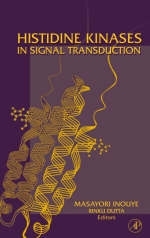
Histidine Kinases in Signal Transduction
Academic Press Inc (Verlag)
978-0-12-372484-7 (ISBN)
Living cells are constantly sensing environmental changes, and their abilities to sense these changes and adapt to them are essential for their survival. In bacteria, histidine kinases are the major sensors for these environmental stresses, enabling cells to adapt to new growth conditions.
Written by leading experts in the field, this book provides an up-to-date and comprehensive review on the structure and function of histidine kinases. It also provides extensive information on the physiological roles of histidine kinases in bacteria and eukaryotes.
An an essential reference for cell biologists, microbiologists, molecular biologists, and biochemists interested in signal transduction. Experimental biologists and pharmacologists studying signal transduction systems in living organisms will also find it a valuable research tool.
Preface
Contributors
1 Histidine Kinases: Introductory Remarks
Introduction
Basic Structure of Histidine Kinases (HKs)
Uniqueness of HKs
Difference between HKs and Ser/Thr/Tyr Kinases
Signal Transduction Mechanism
Regulation of Kinase and Phosphatase Activities: Switch Model and Rheostat Model
Concluding Remarks
References
2 The Histidine Kinase Family: Structures of Essential Building Blocks
Introduction
Kinase/Phosphatase Core Domain
Phosphotransfer Domain
Considerations on Domain Interactions
Concluding Remarks
References
3 Regulation of Porins in Escherichia coli by the Osmosensing Histidine Kinase~hosphatase EnvZ
Introduction
Domain A Is the Catalytic Domain
Domain B Is the Catalysis-Assisting and ATP-Binding Domain
Monomeric Histidine Kinase: Topological Arrangement between Domain A and Domain B
Role of DNA in EnvZ Function
Stoichiometric Complex Formation between EnvZ and OmpR
Regulation of Kinase and Phosphatase Activities: Switch Model versus Rheostat Model
Mechanism of Osmoregulation
Concluding Remarks
References
4 Structure and Function of CheA, the Histidine Kinase Central to Bacterial Chemotaxis
Introduction
Modular Structure of CheA
A Superfamily of Histidine Kinases and ATPases
Nucleotide Binding by CheA P4 and the GHL ATPases
ATP Hydrolysis and Conformation of P4
HPt Domain P1 and Phosphoryl Transfer
P2 Domain and Response Regulator Coupling
A Separate Dimerization Domain
Receptor Coupling by the P5 Regulatory Domain
Is Flexibility between Domains Important for Signaling?
Controlling Protein-Protein Interactions with ATP
Prospects for the Design of Antibiotics Directed at CheA
What Is Next?
References
5 Transmembrane Signaling and the Regulation of Histidine Kinase Activity
Introduction
Membrane Receptor Kinases
Type I Histidine Kinase Receptors
Receptors with Several Membrane-Spanning Segments
Transmembrane Signaling in Bacterial Chemotaxis
Conclusions
References
6 Structure-Function Relationships: Chemotaxis and Ethylene Receptors
Introduction
Chemotaxis and Chemoreceptors
The Ethylene Receptor
Chemoreceptors and Membrane-Bound Histidine Proteins Kinases
References
7 New Insights into the Mechanism of the Kinase and Phosphatase Activities of Escherichia coli NRH (NtrB) and Their Regulation by the PII Protein
Introduction
Mechanism of NRII Autophosphorylation and Regulation of This Activity by PII
Regulation of the Transphosphorylation Activity of NRII by PII
Evidence for Conformational Alteration of NRII by PII Binding
Mapping the Interaction of PII with NRII
Mapping the Activities of NRII
Explaining the Activities of Mutant Forms of NRII
References
8 Role of the Histidine-Containing Phosphotransfer Domain (HPt) in the Muhistep Phosphorelay through the Anaerobic Hybrid Sensor, ArcB
Introduction
HPt Domain
Structure and Function of Common HPt Domains
Multistep ArcB?ArcA Phosphorelay System in Escherichia coli Anaerobiosis
Advantage of Multistep Phosphorelay
Multisignaling Circuitry of the ArcB?ArcA Phosphorelay
Phospho-HPt Phosphatase Is Involved in the ArcB?ArcA Signaling Circuitry
Physiological Role of SixA-Phosphatase in Response to Anaerobic Respiratory Conditions
Cross-Phosphorelay Occurs on OmpR through EnvZ Osmosensor and ArcB Anaerosensor
Atypical HPt Factor Is Involved in the Multistep RcsC?YojN?RcsB Phosphorelay
HPt Domains in Higher Plants
Concluding Remarks
References
9 Genome-Wide Analysis of Escherichia coli Histidine Kinases
Introduction
Histidine Kinase Genes in the E. coli Genome
Versatility of E. coli Histidine Kinases
Deletion Analysis of Every Histidine Kinase Gene in the E. coli Genome
DNA Microarray Analysis of Histidine Kinases for Gene Regulations
References
10 Signal Transmission and Specificity in the Sporulation Phosphorelay of Bacillus subtilis
Introduction
Structural Characterization of Phosphorelay Components
Interactions of the Response Regulator with the Phosphotransferase Domain
Conclusion
References
11 Histidine Kinases: Extended Relationship with GHL ATPases
Introduction
Diverse Functions Supported by a Conserved ATP-Binding Site
Features of the ATP-Binding Site
Mechanistic Implications
Closing Remarks
References
12 Response Regulator Proteins and Their Interactions with Histidine Protein Kinases
Introduction
Regulatory Domains
Effector Domains
Regulation of Response Regulatory Phosphorylation
Interactions of Response Regulators with Histidine Kinases and Histidine-Containing Phosphotransfer Domains
Perspectives
References
13 Cyanophytochromes, Bacteriophytochromes, and Plant Phytochromes: Light-Regulated Kinases Related to Bacterial Two-Component Regulators
Introduction to Phytochromes (Phys)
Phys as Proteins Kinases?
Discovery of Cyanophytochromes (CphPs) and Bacteriophytochromes (BphPs)
Photochemical Properties of CphPs and BphPs
Histidine Kinase Domains and Kinase Activity for CphPs and BphPs
Biological Functions of Prokaryotic Phys
Do Higher Plant Phys Function as Two-Component Histidine Kinases?
Functions of the Kinase Activity of Phys
BphP, CphP, and Phy Evolution
Conclusions
References
14 Histidine Kinases in the Cyanobacterial Circadian System
Introduction
Cyanobacterial Circadian Rhythms
Molecular Genetics of Cyanobacterial Circadian System: Kai Genes
SasA, a KaiC-Binding Histidine Kinase as a Circadian Amplifier
CikA, a Bacteriophytochrome Family Histidine Kinase as a Circadian Photic Input Factor
Perspectives: Toward Further Understanding of His-to-Asp Signaling
Pathways in the Circadian Network in Cyanobacteria
References
15 Two-Component Control of Quorum Sensing in Gram-Negative Bacteria
Introduction
Quorum Sensing in Vibrio harveyi
Quorum Sensing in Myxococcus xanthus
Conclusions
References
16 Intercellular Communication in Gram-Positive Bacteria Depends on Peptide Pheromones and Their Histidine Kinase Receptors
Introduction
Intercellular Communication by Unmodified Peptides
Intercellular Communication by Modified Peptides
Bacteria Speak Different Languages
Peptide Pheromones Depend on Histidine Kinase Receptors
The HPK10 Subfamily of Histidine Kinases
References
17 Initiation of Bacterial Killing by Two-Component Sensing of a "Death Peptide": Development of Antibiotic Tolerance in Streptococcus pneumoniae
Introduction
Cell Death and Signal Transduction
Summary and Perspectives
References
18 Role of Multiple Sensor Kinases in Cell Cycle Progression and Differentiation in Caulobacter crescentus
Introduction
Temporal and Spatial Control of Cell Cycle Events
Levels of Developmental Regulation
Control of Differentiation by Cell Cycle Checkpoints
Two-Component Signal Transduction and Cell Cycle Regulation
Summary and Perspectives
References
19 The Slnl-Ypdl-Sskl Multistep Phosphorelay System That Regulates an Osmosensing MAP Kinase Cascade in Yeast
Introduction
The Common Downstream Pathway
The SLN 1 Branch
The SHO 1 Branch
Concluding Remarks
References
20 Histidine Kinases of Dictyostelium
Introduction
Eukaryotic Histidine Kinases
Dictyostelium Histidine Kinases
Phenotypic Analyses
Double Mutants
Structure and Function of DhkA
The Late Adenylyl Cyclase ACR
Summary and Perspectives
References
21 Ethylene Perception in Arabidopsis by the ETR1 Receptor Family: Evaluating a Possible Role for Two-Component Signaling in Plant Ethylene Responses
Introduction
ETR1 Family Gene Structure and Biochemistry
Ethylene Sensor Domain
GAF-like Domain
Histidine Kinase-Coupled Receptor
Receiver Domain
Kinase Activity in the Cytosolic Portion of ETR1
Mutational Analysis of the Ethylene Pathway
TwomComponent Signaling through MAPk Kinases in Saccharomyces cerevesiae and Arabidopsis
References
22 Pathogenicity and Histidine Kinases: Approaches Toward the Development of a New Generation of Antibiotics
Introduction
Are Histidine Kinases Good Antibacterial Targets?
Alternatives to High Throughput Screens: Possibilities for Structure-Based Screening for Identification Histidine of Kinase Inhibitors
References
23 Molecular Evolution of Histidine Kinases
Introduction
Domains of Histidine Kinases
Evolution of Histidine Kinases
Conclusion
References
Index
| Erscheint lt. Verlag | 13.11.2002 |
|---|---|
| Verlagsort | San Diego |
| Sprache | englisch |
| Maße | 152 x 229 mm |
| Gewicht | 930 g |
| Themenwelt | Naturwissenschaften ► Biologie ► Zellbiologie |
| ISBN-10 | 0-12-372484-8 / 0123724848 |
| ISBN-13 | 978-0-12-372484-7 / 9780123724847 |
| Zustand | Neuware |
| Haben Sie eine Frage zum Produkt? |
aus dem Bereich


